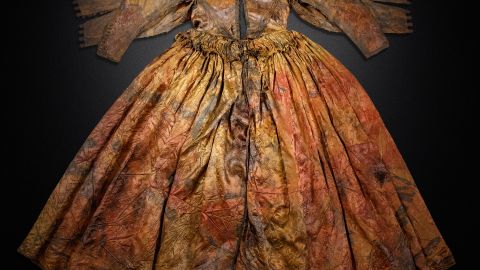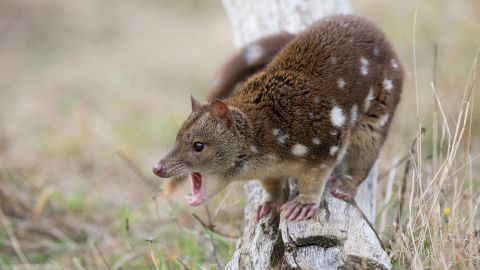
A version of this story appeared in CNN’s Wonder Theory science newsletter. To get it in your inbox, sign up for free here.
CNN
—
I’ll never forget reading “Treasure Island” as a kid.
Robert Louis Stevenson’s novel made me want to set out immediately on a tall-masted ship and seek adventure — and maybe a little buried gold, too. Surely, there was something out there that no one had ever found, waiting to be discovered.
Over time, I’ve realized that treasure is a relative term, and these days the answers to some of history’s many mysteries feel like the true reward at the end of a journey.
Now, shifting sands beneath the waves have revealed an unlikely time capsule that is a trove of insights about what life was like centuries ago.
Ocean secrets
A Dutch merchant ship filled with chests of luxury goods sank off the coast of Texel, the largest island in the North Sea, nearly four centuries ago.
Many of the recovered items, now housed at the Netherlands’ Museum Kaap Skil, are virtually as pristine as the day they went beneath the waves.
The unidentified ship has long since deteriorated, but chests protected lavish clothing, gilded leather book covers and silver items that likely once belonged to an affluent family on a voyage to live somewhere else.
Perhaps the most remarkable items are two virtually intact silk gowns, including a wedding dress interwoven with sparkling silver disks.
Across the universe
A ghostly occurrence is taking place in Saturn’s rings, and the Hubble Space Telescope captured the phenomenon in action.
Smudgy “spokes” have appeared in the planet’s rings as Saturn enters a new season. The fleeting spots that seem to skate along the rings usually appear during an equinox.
Hoping to solve the mystery, NASA scientists will use Hubble to continue observations as the autumnal equinox for the planet’s northern hemisphere, expected in 2025, approaches.
Meanwhile, a glowing new portrait of the sun captured by a trio of telescopes showcases our star’s hidden light. And the James Webb Space Telescope peered into a glittering megacluster of galaxies that pointed to even fainter objects in the distant universe.
Trailblazers

For years, scientists questioned how to fill a single square in the seventh row of the periodic table of elements.
Called Element 117, it would need to be created in a lab, like other superheavy elements that don’t exist in nature.
Nuclear chemist Clarice Phelps and her team at the Oak Ridge National Laboratory in Tennessee began painstaking work in 2012 to create the element. Four years later, the element, officially named tennessine, was added to the periodic table.
Phelps became the first Black woman involved in an element’s discovery, and she has faced challenges and biases along the way, even when it came to getting recognition for her accomplishment. The obstacles only made her fight harder.
“I want to be that person for that little girl who’s looking for somebody that looks like them, doing things that people say they can’t do,” Phelps said.
A long time ago
Laser technology that can peer beneath the dense rainforests of Guatemala has revealed new insights into early Mayan civilization.
Researchers uncovered a previously unknown Maya site that included more than 900 settlements across 417 interconnected ancient cities, towns and villages.
Connecting these communities was a sprawling network of raised stone trails, called causeways, that rose above the swamps and dense forest of the Maya Lowlands.
“They’re the world’s first superhighway system that we have,” said archaeologist Richard Hansen of Idaho State University.
The Maya people made sure their causeways were visible even at night, using a technique that would reflect the moonlight.
Wild kingdom

Human relationships can feel difficult to navigate even on the best of days. For animals, courtship rituals can be even more bizarre.
The northern quoll, a carnivorous marsupial, has stumped researchers because the males die after a single mating season. Their demise might be the result of males being driven to find and mate with as many females as possible, with little rest in between.
Meanwhile, the tiny male deep-sea anglerfish, which can be one-sixtieth the size of a female, clings to his partner’s belly with pincerlike teeth.
And then there are female whiptail lizards, which have evolved to the point that they don’t need male mates at all.
Explorations
Get caught up in these fascinating stories:
— A rare dolphin in the Amazon River, a colossal whale shark and a marine jungle are just some of the highlights of the 2023 Underwater Photographer of the Year competition.
— Researchers found a record-breaking footprint left by a carnivorous dinosaur that once stalked the coast of Yorkshire in the United Kingdom 166 million years ago.
— It’s not a bird, a plane or aliens. Here’s how high-altitude balloons, like those recently spotted in the skies over North America, are actually used.
Like what you’ve read? Oh, but there’s more. Sign up here to receive in your inbox the next edition of Wonder Theory, brought to you by CNN Space and Science writers Ashley Strickland and Katie Hunt. They find wonder in planets beyond our solar system and discoveries from the ancient world.




